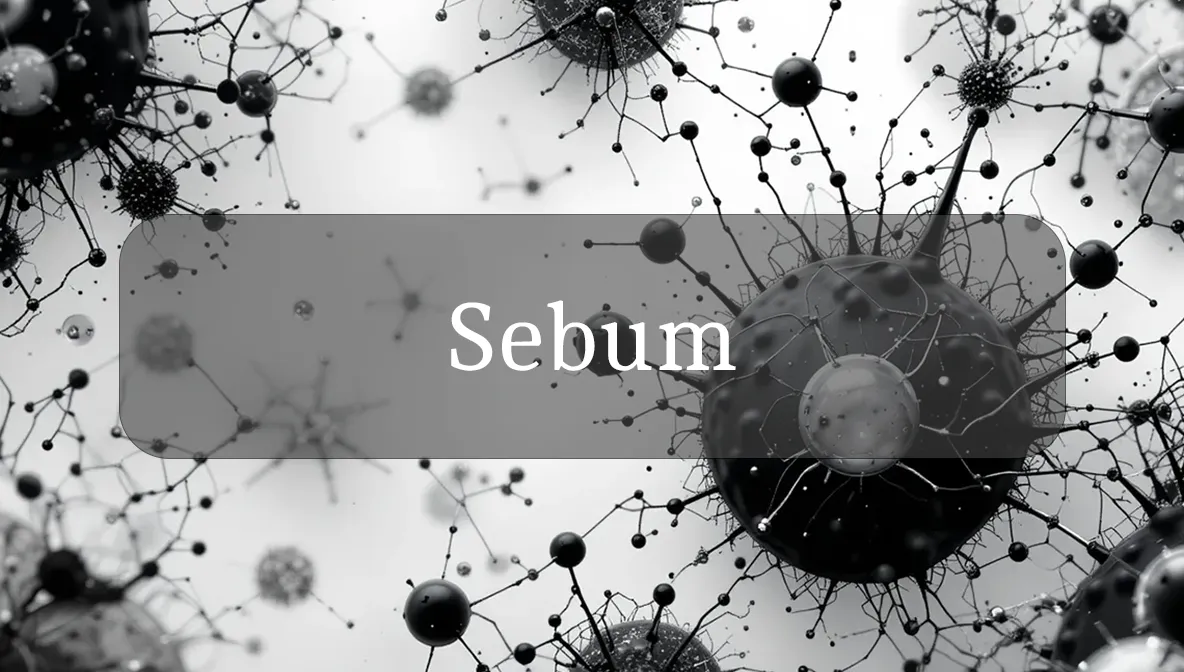Your Skin’s Natural Moisturizer
Sebum is the oily substance your skin produces to keep itself soft, hydrated, and protected. Think of it as your body’s built-in lotion, working quietly to maintain healthy skin and hair. Let’s explore what sebum is, how it supports your wellness, and how to keep it balanced for a glowing, healthy you.
Identity and Function
Sebum is a waxy, oily fluid secreted by sebaceous glands, which are tiny glands found in your skin, especially on your face, scalp, and upper back. It’s made of fats (like triglycerides), wax esters, squalene, and cholesterol. Sebum’s main job is to coat your skin and hair, forming a protective barrier that locks in moisture, shields against germs, and keeps your skin supple.
Health Benefits and Physiological Role
Sebum is a skin superhero with several key benefits:
- Moisturizes Skin: It prevents dryness, flaking, or cracking by keeping your skin hydrated and smooth.
- Protects Against Germs: Sebum has antimicrobial properties that help fend off harmful bacteria and fungi, reducing the risk of skin infections.
- Shields from Damage: It forms a barrier against environmental stressors like UV rays, pollution, and harsh weather, protecting your skin’s health.
- Keeps Hair Healthy: Sebum coats hair strands, giving them shine and preventing brittleness or breakage.
- Supports Skin Barrier: By maintaining your skin’s natural lipid layer, sebum helps prevent irritation and conditions like eczema.
Sebum keeps your skin and hair looking vibrant while supporting your body’s first line of defense against the outside world.
Production and Sources
Your body produces sebum naturally:
- How It’s Made: Sebaceous glands, located near hair follicles, secrete sebum in response to hormones (like androgens) and body signals. Production peaks during puberty and varies with age, genetics, and stress.
- Dietary Influence: Healthy fats (from avocados, nuts, fish) and nutrients like vitamin A (carrots, spinach) and zinc (seeds, lentils) support sebum’s lipid production.
- Environmental Factors: Hot, humid climates or stress can increase sebum output, while dry or cold weather may reduce it.
- No External Sources: Sebum isn’t consumed; it’s made from your diet’s building blocks and your body’s processes.
A balanced diet and lifestyle help your glands produce just the right amount of sebum.
Signs of Imbalance
Too much or too little sebum can affect your skin’s health:
- Excess Sebum:
- Oily skin, shiny T-zone (forehead, nose, chin), or clogged pores.
- Acne or blackheads, as sebum mixes with dead skin cells and bacteria.
- Greasy scalp or hair that looks oily soon after washing.
- Too Little Sebum:
- Dry, flaky, or tight skin, especially in winter or with aging.
- Itchy or irritated skin, prone to redness or cracking.
- Dull, brittle hair lacking natural shine.
- Abnormal Sebum:
- Persistent acne or cysts may signal hormonal imbalances affecting sebum.
- Foul-smelling sebum with redness may indicate infection (e.g., folliculitis).
If you notice chronic oily skin, severe acne, or persistent dryness, see a dermatologist to check for conditions like hormonal issues or dermatitis.
Supporting Healthy Function
To keep your sebum balanced and skin glowing:
- Cleanse Gently: Wash your face twice daily with a mild cleanser to remove excess sebum without stripping natural oils. Avoid harsh soaps that dry out skin.
- Moisturize Smartly: Use non-comedogenic (non-pore-clogging) moisturizers to hydrate without adding oil, even if you have oily skin.
- Eat a Balanced Diet: Include omega-3s (salmon, flaxseeds), vitamin A (sweet potatoes, kale), and zinc (nuts, beans) to support healthy sebum production.
- Stay Hydrated: Drink 8–10 cups of water daily to keep skin hydrated from within, complementing sebum’s efforts.
- Manage Stress: Stress hormones can boost sebum production, so try yoga, meditation, or deep breathing to stay calm.
Safety and Precautions
Sebum is a natural body fluid, but skin health requires care:
- Medical Conditions: Acne, seborrheic dermatitis, or hormonal disorders (like PCOS) can disrupt sebum production. Consult a dermatologist for tailored treatment.
- Skincare Products: Avoid heavy, oil-based products if you have oily skin, and steer clear of alcohol-based products if your skin is dry, as they can worsen imbalances.
- Medications: Retinoids or hormonal treatments (e.g., birth control) can affect sebum. Use only as prescribed and monitor skin changes.
- Infections: If sebum-filled pores become infected (e.g., painful acne or scalp bumps), seek medical advice to prevent complications.
- Sun Protection: Sebum offers some UV protection, but it’s not enough—use SPF 30+ sunscreen daily to shield your skin.
If you have persistent skin issues or suspect a hormonal imbalance, consult a healthcare provider for tests or treatments.
Fun Fact
Did you know sebum is unique to mammals? It’s why humans, cats, and dogs have soft, shiny hair and skin, while reptiles rely on scales for protection. Your sebum is like a personalized skincare product made just for you!
Citations
- National Institutes of Health (NIH): Sebaceous Glands and Skin Health.
- Mayo Clinic: Acne and Skin Care Basics.
- Cleveland Clinic: Understanding Skin and Sebum.
- American Academy of Dermatology: Oily Skin and Dry Skin Management.
- Journal of Investigative Dermatology: Sebum Composition and Skin Health (2020).

